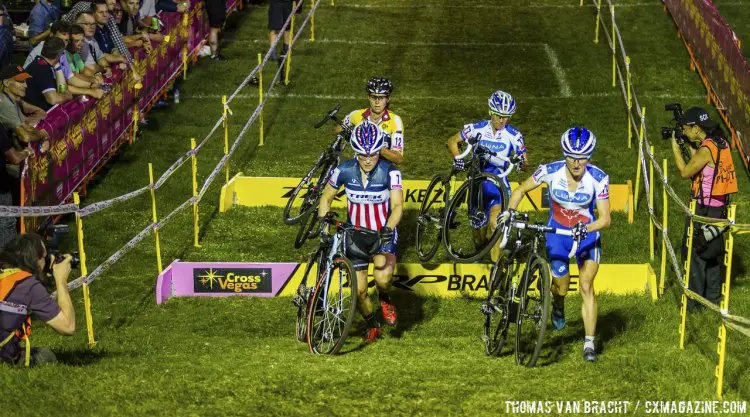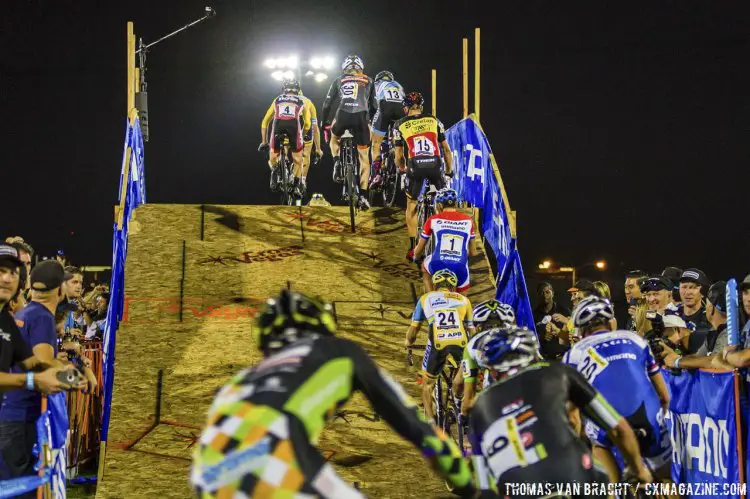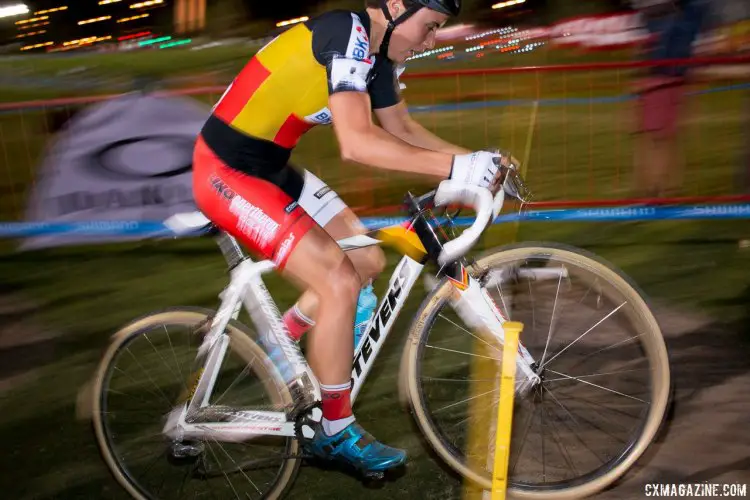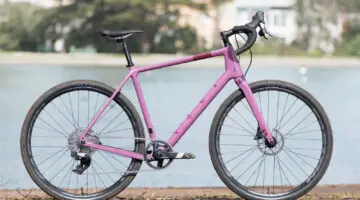The preliminary 2016 CrossVegas UCI Cyclocross World Cup start lists are out, and the United States leads all nations with a whopping 37 participants.
At first glance, the large number of starters seems appropriate for the host country, a fair re-balancing act if you will, since European racers typically have a much easier and cheaper travel burden for all other World Cup stops.
Here’s the country breakdown as it stands now based on the 2016 CrossVegas preliminary start lists:
2016 CrossVegas Cyclocross World Cup Country Racer Count - Elite Women
| Country | Total Racers |
|---|---|
| ARG | 1 |
| BEL | 4 |
| CAN | 8 |
| CZE | 1 |
| FRA | 2 |
| IRL | 1 |
| ITA | 1 |
| NED | 1 |
| USA | 18 |
| Grand Total | 37 |
2016 CrossVegas Cyclocross World Cup Country Racer Count - Elite Men
| Ctry | # Riders |
|---|---|
| BEL | 17 |
| CAN | 7 |
| COL | 2 |
| EST | 1 |
| FRA | 3 |
| GBR | 1 |
| GER | 3 |
| LUX | 1 |
| MEX | 1 |
| NED | 3 |
| UKR | 1 |
| USA | 17 |
| Grand Total | 57 |
While most American fans should be excited that so many U.S. and Candian racers are lining up for the UCI World Cup, shedding our readership-based bias, it’s also surprising how few racers outside of North Americans are attending the first stop of the 2016/2017 UCI Cyclocross World Cup, especially in the women’s race.
As a comparison, here are the country breakdowns of the 2015 Valkenburg World Cup in the Netherlands last year.
2015 Valkenburg Cyclocross World Cup Country Racer Count - Elite Women
| Ctry | # Racers |
|---|---|
| BEL | 8 |
| CZE | 7 |
| DEN | 1 |
| ESP | 3 |
| FRA | 5 |
| GBR | 5 |
| GER | 3 |
| ITA | 2 |
| LUX | 1 |
| NED | 8 |
| POL | 3 |
| SUI | 1 |
| SVK | 1 |
| SWE | 1 |
| USA | 7 |
| Grand Total | 56 |
| # of Countries | 15 |
2015 Valkenburg Cyclocross World Cup Country Racer Count - Elite Men
| Ctry | # Racers |
|---|---|
| BEL | 15 |
| CZE | 8 |
| DEN | 2 |
| ESP | 3 |
| FRA | 5 |
| GBR | 2 |
| GER | 6 |
| ITA | 3 |
| JPN | 1 |
| LUX | 2 |
| NED | 8 |
| POL | 1 |
| SUI | 7 |
| SVK | 1 |
| SWE | 1 |
| USA | 2 |
| Grand Total | 67 |
| # of countries | 16 |
Where Are the Women from Abroad?
Looking deeper into the women’s field in both this year’s CrossVegas and last year’s Valkenburg World Cups, there’s just 11 racers from outside North American racing CrossVegas, whereas 51 women from outside North America raced the Valkenburg stop. Put another way, about 78% of international (outside North America) women World Cup racers who competed in Valkenburg aren’t making the trip to Vegas. It looks even worse if you don’t count U.S.-based Czech Katerina Nash, French Caroline Mani, Irish Maria Larkin (updated) and the Argentinian Gomez-Villafane sisters as non-American. Not counting them, just eight seven racers are making the trip to race under the lights and fight for top UCI and World Cup points.
While it should be no surprise to anyone that women’s racing unfortunately has smaller team budgets, it’s striking how few women are making the trip this year to contest the first UCI World Cup.

It’s a largely North American affair at the 2016 CrossVegas. phoot: The leading four women (Compton, Pendrel, Miller, Nash) before Pendrel crashed in a turn. 2014 CrossVegas © Thomas van Bracht / Peloton Photos
Heading into 2016, with two U.S. UCI World Cup stops, the conventional wisdom was that more international cyclocross racers would make the trip across the pond, because more UCI points were up for grabs and all the travel hours and costs were easier to justify because there was more racing available. However, especially with the women, the opposite appears to true. Last year, at the 2015 CrossVegas, there were 22 women hailing from outside North America, or double the 11 that are attending this year. North Americans were just over half the CrossVegas 45-rider field in 2015, and now project to be 70% of a smaller 38-rider field in 2016.
Two World Cup stops certainly didn’t attract more international women to CrossVegas this year.
More Belgian and American Men, Less Everyone Else
While the men’s CrossVegas World Cup field boasts many more racers making the trip from outside North American than the seven traveling to the women’s race, they’re still down dramatically compared to a European World Cup and last year’s CrossVegas.

2016 brings the current World Champion, but fewer European racers. photo: In 2014, CrossVegas brought top European stars before it was a World Cup. 2014 CrossVegas © Thomas van Bracht / Peloton Photos
For the 2016 CrossVegas World Cup, 32 racers from outside of North America are projected to contest the event. That’s less than half of the 65 non-North American racers who raced last season in Valkenburg, and down from the 43 who lined up at the 2015 CrossVegas.
Again, the possibility of racing two U.S. World Cups (not to mention two additional days of UCI racing on Friday and Sunday at JingleCross) does not seem to have attracted more international racers, but rather reduced the number.
Adding another stop makes for a longer, more complicated and more expensive trip, and could bust the budgets for teams outside of the top Belgian programs.
Leveling the Playing Field, or Cause for Concern?
Any American cyclocross racer, fan or journalist who has made the trip to Europe to take in UCI cyclocross racing knows the time, energy and money required to make such a trip is daunting and taxing. Thus it can be argued that putting European racers through such constraints is only fair. Make them go through all that effort and expense, or have them sacrifice UCI points and World Cup standings, the argument goes.

Perennial World Cup title contender Sanne Cant will make the trip to the U.S. to secure valuable UCI points, but many competitive Europeans will be staying home. photo: Cant persisted with the lead group at the CrossVegas World Cup 2015. © Cyclocross Magazine
While bringing the World Cup to new audiences undoubtedly benefits fans and on paper could level the playing field, it’s also possible that the expansion to the U.S. actually ends up benefiting the best resourced teams (i.e. Belgian) the most. Some might argue that its a bit like the rich getting richer. The Belgian teams can afford to make the trip, clean up on points and get a big head start on World Cup rankings, while other racers and programs will start their World Cup campaign with a two-race disadvantage.
Experience and opportunity provided by the World Cup expansion can’t be discounted, and that alone count justify bringing the series to North America, and in the future, Asia. The U.S. Stops will allow some Americans who don’t travel to Europe the chance to race and earn points at CrossVegas and Jingle Cross.
However, since most Americans outside of the Aspire, Cannondale p/b CyclocrossWorld teams and Katie Compton don’t compete in all European World Cups, the disparity between the few teams and racers that attend all World Cups and the ones that can’t grows even larger with the expansion, making the battle for the World Cup title less competitive, not more.
While the increased travel expenses of two stops and a longer trip are likely to blame for fewer European racers this season, other factors like a relatively stagnant bike industry and once-in-four-years Olympic expenses could also be playing a role. We’re also holding out hope that the preliminary start lists are very preliminary, and other entrants will trickle in between now and the starting gun, and that the final numbers will be a bit bigger.
Whether the decreased numbers are cause for concern depends largely on your expectations of the UCI World Cup. The World Cup can technically expand in terms of countries and number of races while contracting in participants and still help the sport of cyclocross grow as a spectator sport, and indirectly, as a participant sport. By traveling to new locations like Iowa City, more people could be exposed to top-level racing and race production, see the world’s best racers up close and be inspired to eventually try and line up for a race.
However, with just seven women flying from outside North America to contest CrossVegas, will it really feel any different than a UCI C1 event in the States?
When Elvis starts singing the anthem, and Sanne Cant focuses on that guest turn, we’re guessing it will.
Stay tuned as we talk to some of the stakeholders and explore this topic in the next week.



























